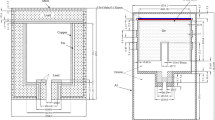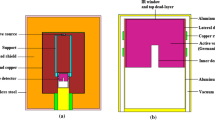Abstract
In this work, an approach for determining both the outer dead layer thickness of the p-type coaxial HPGe detector and the inner dead layer thickness of the n-type coaxial HPGe detector was proposed by using two full energy peak area count ratios of a X-ray and a gamma ray emitted from the same radioisotope of 137Cs. Monte Carlo calculations and experimental measurements were conducted to determine these dead layer thicknesses. The results showed that the outer dead layer thickness reached 0.57 ± 0.03 mm on 06 Jan 2017 after nearly 3 years of use for the p-type detector. The inner dead layer thickness reached 1.21 ± 0.24 mm on 01 Aug 2016 after more than 3 years of operation for the n-type detector. Simulation model with the modified dead layer thicknesses was used to estimate full energy peak efficiencies and gamma spectra from seven radioactive sources. The results were in good agreement with the corresponding experimental values in the gamma energy region of interest.






Similar content being viewed by others
References
Elanique A, Marzocchi O, Leone D, Hegenbart L, Breustedt B, Oufni L (2012) Dead layer thickness characterization of an HPGe detector by measurements and Monte Carlo simulations. Appl Radiat Isot 70:538–542
Boson J, Agren G, Johansson L (2008) A detailed investigation of HPGe detector response for improved Monte Carlo efficiency calculations. Nucl Instrum Meth A 587:304–314
Dryak P, Kovar P (2006) Experimental and MC determination of HPGe detector efficiency in the 40–2754 keV energy range for measuring point source geometry with the source to detector distance of 25 cm. Appl Radiat Isot 64:1346–1349
Andreotti E, Hult M, Marissens G, Lutter G, Garfagnini A, Hemmer S, von Sturm K (2014) Determination of dead layer variation in HPGe detector. Appl Radiat Isot 87:331–335
Huy NQ, Binh DQ, An VX (2007) Study on the increase of inactive germanium layer in a high-purity germanium detector after a long time operation applying MCNP code. Nucl Instrum Meth A 537:384–388
Huy NQ et al (2010) The influence of dead layer thickness increase on efficiency decrease for a coaxial HPGe p-type detector. Nucl Instrum Meth A 621:390–394
Rodenas J, Pascual A, Zarza I, Serradell V, Ortiz J, Ballesteros L (2003) Analysis of the influence of germanium dead layer on detector calibration simulation for environmental radioactive samples using the Monte Carlo method. Nucl Instrum Meth A 496:390–399
Sowa W, Martini E, Gehrcke G, Marschner P, Naziry MJ (1989) Uncertainties of in situ gamma spectrometry for environmental monitoring. Radiat Prot Dosim 27(2):93
Rybacek K, Jacob P, Meckbach R (1992) In-situ determination of deposited radionuclide activities: Improved method using derived depth distribution from the measured photon spectra. Health Phys 62(6):519–528
Loan TTH, Ba VN, Thy THN, Hong HTY (2016) Validation for Monte Carlo simulation of characteristics of gamma spectrometer using HPGe GMX 35P470 detector by MCNP5 and Geant 4 codes. J Sci Ho Chi Minh City Univ Edu 3(81):27–33
X-5 Monte Carlo Team (2005) MCNP5—Monte Carlo N-particle transport code system, Los Alamos National Laboratory. LA-UR-03-1987
Loan TTH, Phuong DN, Thanh TT, Khanh TA, Nhon MV (2007) Monte-Carlo simulation of HPGe detector response function with using MCNP code. Commun Phys 17(1):59–64
Acknowledgements
This study is funded by Vietnam National University Ho Chi Minh City under Grant Number B2017-18-01.
Author information
Authors and Affiliations
Corresponding author
Rights and permissions
About this article
Cite this article
Loan, T.T.H., Ba, V.N., Thy, T.H.N. et al. Determination of the dead-layer thickness for both p- and n-type HPGe detectors using the two-line method. J Radioanal Nucl Chem 315, 95–101 (2018). https://doi.org/10.1007/s10967-017-5637-8
Received:
Published:
Issue Date:
DOI: https://doi.org/10.1007/s10967-017-5637-8




